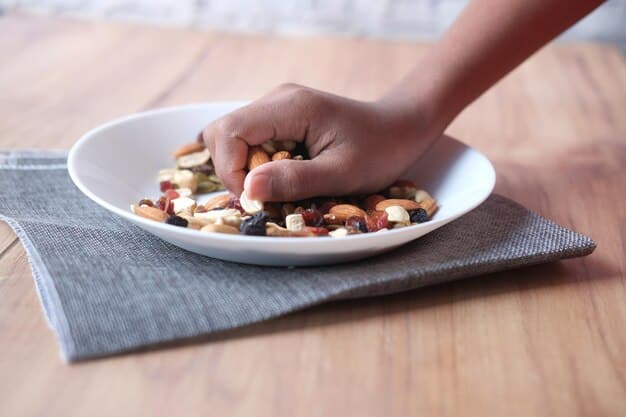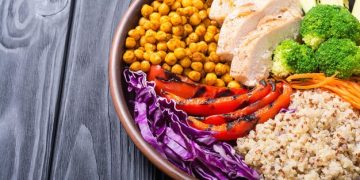The 2025 Guide: Optimizing Calorie Intake for Fat Loss

Optimizing calorie intake for maximum fat loss in 2025 involves a personalized, science-backed approach combining an appropriate calorie deficit with nutrient-dense foods, consistent activity, and understanding individual metabolic responses to ensure sustainable results.
Embarking on a journey to shed fat often brings the fundamental question to the forefront: how crucial is calorie intake? For 2025, the answer remains profoundly significant, as The 2025 Guide to Optimizing Your Calorie Intake for Maximum Fat Loss reveals a refined, nuanced understanding of achieving sustainable results.
understanding the calorie deficit paradigm in 2025
Understanding the calorie deficit is the bedrock of effective fat loss, and in 2025, its principles remain steadfast, albeit with a more personalized application. A calorie deficit simply means consuming fewer calories than your body expends, forcing it to tap into stored fat for energy. This fundamental equation hasn’t changed, but our approach to calculating and maintaining it has become far more sophisticated.
the precision of deficit calculation
In previous years, rule-of-thumb calorie deficits were common, often leading to frustration. Now, precision is key. We consider not just basal metabolic rate (BMR) but also non-exercise activity thermogenesis (NEAT) and the thermic effect of food (TEF) with greater accuracy. Wearable technology and advanced apps provide real-time data, allowing for dynamic adjustments as activity levels or metabolic rates shift.
- Individual Metabolic Rate: Leveraging data from metabolic tests or advanced predictive algorithms for a tailored BMR.
- Activity Multiplier: More accurate tracking of daily movement beyond structured workouts, including NEAT.
- Dynamic Adjustment: Adapting calorie targets weekly or bi-weekly based on progress and body’s response, avoiding plateaus.
Maintaining a moderate deficit, typically 300-500 calories below maintenance, remains the most sustainable and effective strategy for fat loss, preserving lean muscle mass. Larger deficits, while promising faster initial results, often lead to muscle loss, metabolic adaptation, and rebound weight gain, which are outcomes we aim to avoid in 2025’s intelligent fat loss strategies.
Beyond the initial calculation, the quality of calories within that deficit is paramount. Empty calories from processed foods offer little satiety and can lead to nutrient deficiencies, undermining fat loss efforts. Focus on whole, unprocessed foods that provide essential micronutrients and macronutrients, ensuring your body functions optimally even in a deficit. This emphasis on nutrient density within the caloric framework supports both fat loss and overall well-being.
macronutrient ratios: fueling fat loss intelligently
The days of one-size-fits-all macronutrient ratios are largely behind us. In 2025, tailoring your protein, carbohydrate, and fat intake is a cornerstone of optimizing calorie intake for fat loss, recognizing that individual responses vary significantly based on genetics, activity level, and metabolic health. The goal is to maximize satiety, preserve muscle mass, and support energy levels within your defined calorie deficit.
protein: the fat loss powerhouse
Protein remains the undisputed champion for fat loss. Its high thermic effect means your body burns more calories digesting it compared to fats or carbohydrates. More importantly, protein is crucial for preserving lean muscle mass during a calorie deficit, which is vital for maintaining a healthy metabolism. It also promotes satiety, making it easier to stick to your calorie targets. Aim for at least 1.6-2.2 grams of protein per kilogram of body weight, or even higher for active individuals or those in more aggressive deficits.
carbohydrates: strategic energy for performance
Carbohydrates are not the enemy; they are strategic fuel. In 2025, the emphasis is on complex carbohydrates: whole grains, fruits, and vegetables. These provide sustained energy for workouts and daily activities, replenish glycogen stores, and are rich in fiber, which aids digestion and promotes satiety. The timing of carbohydrate intake around workouts can optimize performance and recovery. Individual tolerance and activity levels dictate the exact amount, but sufficient carbohydrates prevent energy crashes and irritability often associated with restrictive diets.
- Fiber-Rich Sources: prioritize whole grains, legumes, and numerous vegetables.
- Workout Timing: Consume carbohydrates before and after exercise to fuel and recover.
- Individual Tolerance: Adjust carb intake based on energy levels and fat loss progress.
Healthy fats are essential for hormone production, nutrient absorption, and overall health. While calorie-dense, they are crucial for satiety and can prevent cravings. Sources like avocados, nuts, seeds, and olive oil should be incorporated in moderation. In 2025, the balance of these macronutrients is about finding what works best for your body, ensuring you’re not just losing weight, but losing fat effectively while feeling good and performing optimally. Experimentation and tracking your body’s response are key to refining your approach for maximal fat loss.
the role of activity in calorie expenditure
Integrating physical activity into your fat loss strategy transcends merely “burning calories”; in 2025, it’s about strategically leveraging movement to enhance your metabolic rate, preserve muscle mass, and improve body composition while optimizing calorie intake. The synergy between what you eat and how you move is profound, creating a more efficient pathway to fat loss.
resistance training: building the metabolic engine
Resistance training is arguably the most critical form of exercise for fat loss. While it may not burn as many calories as cardio during the session itself, its long-term benefits are unparalleled. Building and maintaining muscle mass directly increases your basal metabolic rate (BMR), meaning you burn more calories at rest. In 2025, progressive overload, proper form, and varied routines are essential to continually challenge muscles and stimulate growth, turning your body into a more efficient fat-burning machine. This focus shifts from simply pulling calories out to creating a body that naturally expends more.
cardiovascular exercise: an adaptable tool
Cardiovascular exercise plays a supportive role, aiding in immediate calorie expenditure and improving cardiovascular health. The approach to cardio in 2025 is less about endless, monotonous sessions and more about intelligent application. High-intensity interval training (HIIT) can be highly effective for burning calories efficiently and improving metabolic flexibility. Conversely, low-intensity steady-state (LISS) cardio offers benefits for recovery and can be performed more frequently without excessive stress.
- HIIT Integration: Short, intense bursts followed by recovery periods to maximize calorie burn and EPOC (Excess Post-exercise Oxygen Consumption).
- LISS for Recovery: Gentle walks or cycling to promote blood flow and reduce stress without hindering recovery from resistance training.
- Variety and Enjoyment: Incorporating activities you genuinely enjoy to ensure consistency and adherence.
Beyond structured workouts, focusing on increasing non-exercise activity thermogenesis (NEAT) is a powerful, often overlooked component of calorie expenditure. Simple habits like taking the stairs, walking during phone calls, or parking further away can significantly add to your daily energy output. In 2025, the holistic view of activity—combining purposeful training with increased daily movement—is integral to optimizing calorie expenditure for maximum fat loss, working in tandem with your calorie intake strategy.
nutrient timing and meal frequency: refining your approach
While the total daily calorie intake and macronutrient distribution remain foundational, the discussion around nutrient timing and meal frequency has evolved considerably by 2025. Science suggests that for fat loss, the “when” of eating can complement the “what,” optimizing energy levels, satiety, and muscle preservation within a calorie deficit. This refinement focuses on aligning your eating patterns with your body’s natural rhythms and activity demands.
timing for performance and recovery
The most impactful aspect of nutrient timing often revolves around exercise. Consuming a balanced meal or snack rich in carbohydrates and protein before a workout can provide the necessary fuel for optimal performance. Post-workout, a similar combination helps initiate muscle repair and recovery, minimizing muscle breakdown during a calorie deficit. This strategic fueling supports your body’s ability to adapt and build lean mass, which is critical for long-term fat loss. The focus is on quality nutrients that serve a purpose, rather than rigid windows.
meal frequency for satiety and adherence
The debate over meal frequency—whether three large meals or six smaller ones are better—has largely concluded with personalization as the answer. In 2025, the most effective meal frequency for fat loss is the one that best manages your hunger, energy levels, and integrates seamlessly into your lifestyle, ensuring adherence to your calorie goals. Some individuals thrive on fewer, larger meals, finding it easier to manage total intake and feel satiated. Others prefer more frequent, smaller meals which can help curb intense hunger pangs.
- Pre-Workout Fuel: A small, easily digestible meal or snack with carbs and protein to energize your session.
- Post-Workout Recovery: A combination of fast-acting carbs and protein to replenish glycogen and support muscle repair.
- Individual Preference: Choose the meal frequency that best manages your hunger and allows consistent adherence to calorie targets.
Intermittent fasting, a popular approach, is a variation of meal frequency where eating is restricted to specific windows. While it doesn’t offer a unique metabolic advantage for fat loss over a consistent calorie deficit, many find it an effective tool for managing overall calorie intake by reducing the eating window. In 2025, the key is understanding your body’s response, listening to hunger cues, and choosing patterns that support sustained fat loss without feeling overly restrictive or triggering unwanted cravings.
overcoming common challenges in calorie optimization
Optimizing calorie intake for maximum fat loss isn’t without its hurdles. By 2025, we’ve gained a deeper understanding of common pitfalls and developed more robust strategies to circumvent them. From metabolic adaptation to emotional eating, acknowledging these challenges and having proactive solutions is crucial for sustained progress.
the plateau phenomenon: metabolic adaptation
One of the most frustrating challenges is hitting a fat loss plateau, often due to metabolic adaptation. As you lose weight, your body requires fewer calories to maintain its new, smaller mass. Additionally, metabolic processes can slow down as an evolutionary response to prolonged calorie restriction, making it harder to lose further fat. In 2025, strategies to combat this include:
- Diet Breaks: Periodically increasing calories to maintenance levels for a week or two can signal to your body that food is abundant, helping to reset metabolic processes.
- Refeeds: Strategic, short-term increases in carbohydrate intake to replenish glycogen and potentially boost leptin levels, a hormone that regulates hunger and metabolism.
- Activity Adjustment: Increasing NEAT or varying workout intensity to create a new stimulus for calorie expenditure.
The key is not to panic and drastically cut calories further, which can worsen adaptation. Instead, a strategic, temporary increase in calories or a shift in training can often break the plateau.

navigating hunger, cravings, and emotional eating
Hunger and cravings are inevitable during a calorie deficit. In 2025, managing them effectively involves a blend of smart food choices and psychological strategies. Focusing on high-volume, low-calorie foods (like vegetables, fruits, and lean proteins) can provide satiety without excessive calories. Hydration is also paramount, as thirst can often be mistaken for hunger. Emotional eating, a major sabotage mechanism, requires self-awareness. Identifying triggers and developing non-food coping mechanisms (e.g., exercise, hobbies, mindfulness) is crucial. Prioritizing sleep and managing stress can also significantly reduce cravings and emotional eating tendencies, supporting consistent fat loss.
the future of personalized nutrition and tracking in 2025
The landscape of personalized nutrition and tracking has evolved dramatically by 2025, moving beyond simple calorie counting to a more integrated, data-driven approach. This evolution promises to make optimizing calorie intake for fat loss more precise, adaptable, and ultimately, more successful for the individual.
advanced tracking technologies
Wearable devices and smart apps in 2025 offer unprecedented insights into our metabolic responses and activity levels. Beyond basic step counts, these technologies can track heart rate variability, sleep quality, and even provide rudimentary metabolic insights through breath analysis or continuous glucose monitoring (CGM). This real-time, personalized data helps individuals understand how specific foods, exercise, and lifestyle factors impact their energy expenditure and fat storage, allowing for dynamic adjustments to calorie intake. The era of static calorie goals is being replaced by responsive, adaptive strategies.
genomic and microbiome insights
The most exciting frontier in personalized nutrition lies in understanding our unique biological make-up. By 2025, readily available genomic testing and microbiome analysis are beginning to inform dietary recommendations beyond general guidelines. Knowing how your body processes certain macronutrients, your genetic predisposition to satiety or cravings, or the composition of your gut microbiome can provide tailored insights into the optimal calorie and macro distribution for fat loss.
- Metabolic Testing: More accessible and accurate methods to determine individual resting metabolic rates and fuel utilization.
- Sleep and Stress Tracking: Advanced metrics to understand the impact of recovery and mental state on metabolic function and hunger hormones.
- AI-Powered Recommendations: Algorithms that learn from your personal data (food intake, activity, body response) to suggest optimal calorie adjustments and food choices.
This isn’t about rigid diets based on DNA, but rather about refining general principles based on individual biological predispositions. For example, some individuals might thrive on higher fat diets while others perform better with more carbohydrates, even within the same calorie deficit. This personalized approach avoids the trial-and-error of the past, making the fat loss journey more efficient and sustainable. Integrating these advanced insights with tried-and-true principles creates a powerful framework for optimizing calorie intake for maximum fat loss in 2025.
sustainable strategies for long-term fat loss success
Achieving maximal fat loss is one thing; sustaining it long-term is another. In 2025, the focus has firmly shifted towards developing habits and strategies that are not only effective but also deeply integrated into a healthy lifestyle. This holistic approach moves beyond temporary fixes to cultivate enduring well-being.
mindful eating vs. restrictive dieting
The paradigm of restrictive dieting often leads to rebound weight gain and a negative relationship with food. 2025 emphasizes mindful eating practices. This involves paying attention to hunger and fullness cues, savoring meals, and understanding the emotional drivers behind food choices. Instead of demonizing foods, it promotes balance and moderation. Mindful eating cultivates a deeper connection to your body’s needs, making it easier to naturally adhere to a sustainable calorie intake without feeling deprived. It acknowledges that true fat loss arises from sustainable habits, not aggressive restriction.
lifestyle integration and stress management
Fat loss isn’t solely about calories in, calories out; it’s intricately linked to overall lifestyle. Adequate sleep, chronic stress management, and a supportive social environment are critical components often overlooked in traditional fat loss plans. Stress can elevate cortisol, potentially promoting fat storage, especially in the abdominal area, and increasing cravings. Poor sleep disrupts hunger-regulating hormones like leptin and ghrelin. In 2025, integrating stress-reducing practices (meditation, nature walks, hobbies) and prioritizing sleep are recognized as non-negotiable for long-term fat loss success.
- Prioritize Sleep: Aim for 7-9 hours of quality sleep to regulate hunger hormones and support recovery.
- Stress Reduction: Implement daily practices that mitigate stress and its physiological impact on fat storage.
- Social Support: Engage with like-minded individuals or seek professional guidance for accountability and motivation.
Celebrating non-scale victories, such as improved energy levels, better sleep, increased strength, or clothes fitting better, serves as a powerful motivator and reinforces positive behavioral change. These strategies, combined with a personalized and adaptable approach to calorie optimization, form the cornerstone of sustainable fat loss in 2025, ensuring that results are not just achieved but maintained for a healthier, more vibrant life.

| Key Optimization Point | Brief Description |
|---|---|
| 📊 Precision Calorie Deficit | Calculate BMR + NEAT, dynamic adjustments for sustainable fat loss. |
| 🥩 Optimal Macronutrient Ratios | Tailor protein, carbs, & fats for satiety, muscle preservation, and energy. |
| 🏋️ Strategic Activity & NEAT | Prioritize resistance training, smart cardio, and increased daily movement. |
| 🧬 Personalized Nutrition Tech | Utilize genomic, microbiome data, and AI for truly customized plans. |
Frequently Asked Questions about Calorie Optimization for Fat Loss
A calorie deficit compels your body to use stored energy (primarily fat) for fuel because the energy from food is insufficient. This energy imbalance forces the body to release fatty acids from adipose tissue into the bloodstream, where they are then metabolized by various tissues for energy, gradually reducing overall body fat stores when consistently maintained.
While calorie counting is a precise tool, fat loss is possible without it. Strategies like portion control, mindful eating, increasing protein and fiber intake, focusing on whole, unprocessed foods, and consistent physical activity can naturally lead to a calorie deficit. The success depends on achieving that deficit through behavioral changes, even if you’re not tracking numbers rigorously.
Macronutrient balance is highly important, especially protein. While a calorie deficit is fundamental, adequate protein intake (1.6-2.2g/kg body weight) helps preserve lean muscle mass during deficit, boosts satiety, and has a higher thermic effect. Balanced carbs and fats ensure energy, micronutrient intake, and hormonal health, all supporting sustainable fat loss and overall well-being.
Absolutely. Chronic stress can elevate cortisol, promoting belly fat storage and increasing cravings, making adherence to a calorie target difficult. Poor sleep disrupts leptin and ghrelin, hormones that regulate hunger and satiety, often leading to increased calorie intake and reduced energy for activity. Optimizing sleep and managing stress are crucial, albeit indirect, aspects of calorie optimization.
Advanced tracking technologies, including wearables and smart apps, provide personalized, real-time data on activity levels, metabolic responses, and sleep quality. These insights allow for dynamic adjustments to calorie intake and exercise, moving beyond static goals. Genomic and microbiome insights further refine dietary recommendations, making the fat loss journey more precise, efficient, and tailored to individual biological predispositions compared to traditional methods.
Conclusion
Optimizing calorie intake for maximum fat loss in 2025 is an intricate yet empowering endeavor, moving far beyond simplistic equations. It demands a holistic, personalized approach, integrating precise deficit calculations, intelligent macronutrient distribution, and strategic physical activity. Furthermore, leveraging advancements in personalized nutrition, understanding the nuances of nutrient timing, and proactively addressing common challenges like metabolic adaptation and stress are paramount. Ultimately, true long-term success lies not just in short-term calorie restriction, but in cultivating sustainable habits, fostering mindful eating, and prioritizing overall well-being to ensure fat loss is not merely achieved, but maintained for a healthier, more vibrant future.





